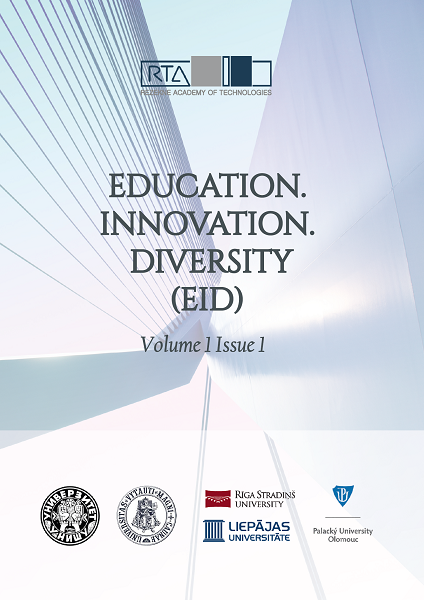MEASUREMENTS OF STUDENTS’ WELLBEING – CASE STUDY IN A LATVIAN PRIVATE SCHOOL
DOI:
https://doi.org/10.17770/eid2020.1.5333Keywords:
cognitive wellbeing, psychological wellbeing, physical wellbeing, social wellbeing, student wellbeing, case studyAbstract
Currently, there is too much emphasis on academic attainment and rankings, and not enough focus on the student wellbeing in basic school. However, the education system (especially in the context of the Covid-19 pandemic) has a significant opportunity to influence the health and habit formation of students who spend the greatest part of the day at school. There have been relatively few studies on student wellbeing in Latvia. The most significant research has been carried out in collaboration with the researchers from the Baltic countries (Estonia, Lithuania). The novelty of this research is related to the development of the theoretically and methodologically based indicators for measuring student wellbeing in an educational institution. The developed indicators will allow the teachers to clarify the situation, draw conclusions and improve the organizational culture. The goal of the research is to find out which indicators reflect the student wellbeing and how to measure them. Based on the study and theoretical findings about the wellbeing indicators there was developed the questionnaire, which consists of self-assessment check list filled by students and evaluation check list filled by parents and teachers. The indicators were united into four wellbeing dimensions: mental wellbeing, cognitive wellbeing, social wellbeing, and physical wellbeing. The following participants filled in the check list and participated in the approbation of the questionnaire: 18 students ages 9-12, 18 parents and 18 teachers. It was suggested to assess the statements related to social, cognitive, physical and mental wellbeing following the Likert scale. The data obtained in the survey was coded and processed in the program SPSS 25.0, using the Frequency test, T-test, ANOVA test. Results indicated that students' sense of wellbeing is changeable. It is influenced by students’ age and gender, and their personal value system. Therefore, measurement of student wellbeing should be done on regular bases. This will allow teachers to create an appropriate environment for the student, as well as to identify problems in a timely manner and, if necessary, start pedagogical correction work.Downloads
References
Agency for International Programs for Youth, Republic of Latvia (2019). Wellbeing of Young People in Baltic States: Research Report. Riga-Tallin-Vilnius. http://www.bernulabklajiba.lv/wp-content/uploads/2019/04/Well-being-of-Young-People-in-the-Baltic-States_2018_ENG_Final.pdf
Aber, J., L. et al. (1997). The effects of poverty on child health and development. Annual Review of Public Health, Vol. 18/1, 463–483. Doi: http://dx.doi.org/10.1146/annurev.publhealth.18.1.463.
Becker, P. (1991). Terminologie und Struktur des Wohlbefindens. In: A.Abele, P.Becker Hrsg.: Wohlbefinden Theorie-Empirie – Diagnostik Juventa (pp.13-16). Weiheim und München.
Bobowik, M., Basabe, N., Paez, D., Jimenez-Aristizabal, A., & Bilbao, M. A. (2011). Personal values and wellbeing among Europeans, Spanish natives and immigrants to Spain: Does the culture matter? Journal of Happiness Studies, 12, 401–419. Doi:10.1007/s10902-010-9202-1
Borgonovi, F. & Pál, J. (2016). A framework for the analysis of student wellbeing in the PISA 2015 study. OECD Education Working Papers, No. 140, OECD Publishing, Paris. Doi: http://dx.doi.org/10.1787/5jlpszwghvvb-en
Costigan, S. A., Lubans, D. R., Lonsdale, C., Sanders, T., & del Pozo Cruz, B. (2019). Associations between physical activity intensity and wellbeing in adolescents. Preventive medicine, 125, 55-61. Doi: https://doi.org/10.1016/j.ypmed.2019.05.009
Diaz, D., Blanco, A., & Mar, D. M. (2011). The Structure of wellbeing: The empirical encounter of three traditions. Revista De Psicologia Social, 26(3), 357-372.
Doi: https://doi.org/10.1174/021347411797361266
Fischer, R. & Boer, D. (2016). Values: the dynamic nexus between biology, ecology and culture. Current Opinnion Psychology, 8, 155–160. Doi: https://doi.org/10.1016/j.copsyc.2015.12.009
Frank, E. (2004). Physician health and patient care. Journal of the American Medical association, 291(5), 637. doi:10.1001/jama.291.5.637
Lyubomirsky, S., Sheldon, K. M., & Schkade, D. A. (2005). Pursuing happiness: The architecture of sustainable change. Review of General Psychology, 9, 111–131. Doi:10.1037/1089- 2680.9.2.111
Nordic Council of Minister’s Office in Latvia, Žiburio Fondas, Latvian Child Welfare Network, Lapse Huvikaitse Koda (2017). Wellbeing and Welfare of Children in Baltic Countries: Study Report and Recomendations. http://www.bernulabklajiba.lv/wp-content/uploads/2017/06/Children-Well-Being-in-Baltic-Countries_Report_2017_final.pdf
OECD (2017). PISA 2015 Results (Volume III): Students’ WellBeing. PISA, OECD Publishing, Paris. http://dx.doi.org/10.1787/9789264273856-ne
Pollard, E. L., & Lee, P. D. (2003).Child wellbeing: A systematic review of the literature. Social Indicators Research, Vol. 61/1, 59–78, http://dx.doi.org/10.1023/A:1021284215801 .
Price, D., & McCallum, F. (2016). Wellbeing in education. In: McCallum, F. & Price, D. (eds). Nurturing wellbeing development in education: From little things, big things grow. London, New York: Routlege, 1-21.
Rath, T., Harter, J. & Harter, J., K. (2010). Wellbeing: The Five Essential Elements. New York: Gallup Press.
Ryff, C. D., & Keyes, C. L. M. (1995). The structure of psychological wellbeing revisited. Journal of personality and social psychology, 69(4), 719.
Sortheix, F.M. & Lönnqvist, J.E. (2014). Personal value priorities and life satisfaction in Europe the moderating role of socioeconomic development. Journal of Cross-Cultural Psychology, 45(2), 282–299. Doi: https://doi.org/10.1177%2F0022022113504621
Sortheix, F.M. & Lönnqvist, J.E. (2015). Person-group value congruence and subjective wellbeing in students from Argentina, Bulgaria and Finland: the role of interpersonal relationships. Journal of Community & Applied Social Psycholology, 25(1), 34–48. Doi: https://doi.org/10.1002/casp.2193
Statham, J., & Chase, E. (2010). Childhood Wellbeing: A Brief Overview. Childhood Wellbeing Research Centre, Loughborough, UK.
Tobia, V., Greco, A., Steca, P., & Marzocchi, G. M. (2019). Children’s wellbeing at school: A multi-dimensional and multi-informant approach. Journal of Happiness Studies, 20(3), 841-861. Doi: 10.1007/s10902-018-9974-2
Wydra, G. (2014). Der Fragebogen zum allgemeinen habituellen Wohlbefinden. Retrieved from http://www.sportpaedagogik-sb.de/pdf/FAHW-Manual.pdf


